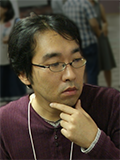Kiwamu Nishida

Commendation
Research on Earth’s background free oscillations
A list of five major papers
- Teleseismic S wave microseisms, Nishida, K., R. Takagi, Science, 2016, Vol. 353, 919-921, doi:10.1126/science.aaf7573.
- Source spectra of seismic hum, Nishida, K., Geophys. J. Int., 199, 1, 416–429, doi: 10.1093/gji/ggu272,2014.
- Background Love and Rayleigh waves simultaneously generated at the Pacific Ocean floors, Nishida, K., H. Kawakatsu, Y. Fukao, and K. Obara, Geophys. Res. Lett., 35, L16307, doi:10.102, 2008.
- Three-dimensional crustal S-wave velocity structure in Japan using microseismic data recorded by Hi-net tiltmeters, Nishida, K., H. Kawakatsu, and K. Obara, J. Geophys. Res., 113, B10302, doi:10.102, 2008.
- Resonant Oscillations Between the Solid Earth and the Atmosphere, Nishida, K., N. Kobayashi and Y. Fukao, Science, 287, 5461, 2244-2246, 2000.
Major achievements
Since the late 1990s, Dr. Kiwamu Nishida has been leading the development of the “Earth’s background free oscillation” which is a Earth’s free oscillation without quaking.
The main results can be summarized in the following three points.
(1) It was clarified that background free oscillation occurs in both spheroidal and toroidal modes.
(2) In the frequency band higher than 5 mHz, the free oscillations aregenerated by topographic coupling between the ocean infragravity wave and the seismic waves on the seafloor, and in the lower frequency band, the atmospheric pressure disturbance also contributes the excitations.
(3) He developed a method to estimate the three-dimensional internal seismic velocity structure by applying the seismic interferometry to the background free oscillation data. The crustal and mantle structures were estimated from the data completely independent of earthquake data.
Dr. Nishida has been highly praised internationally for his ability to analyze the coupling phenomena of the atmosphere, ocean, and solid earth and for his success in estimating the internal structure of the earth using seismic interferometry.
